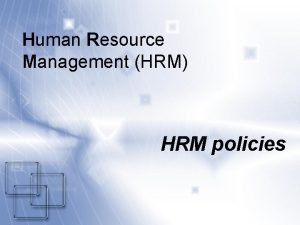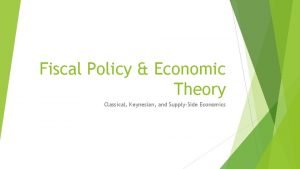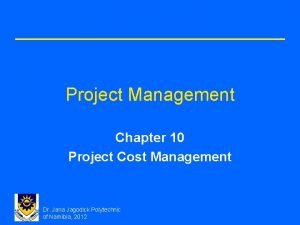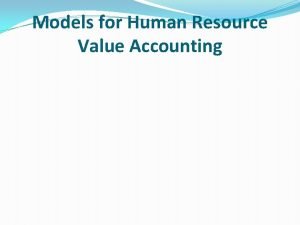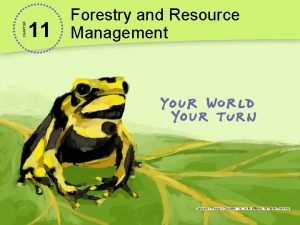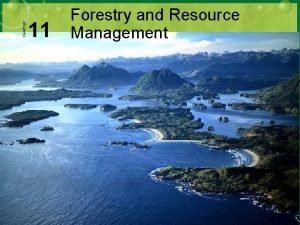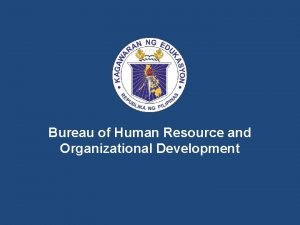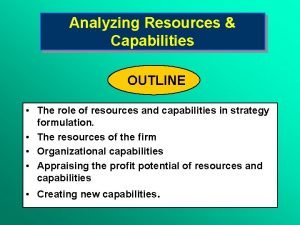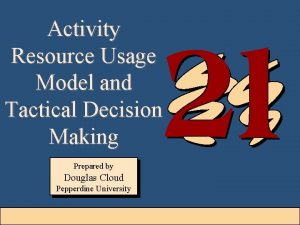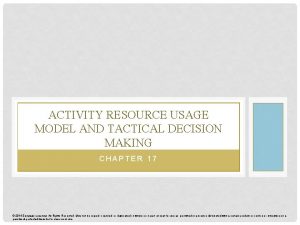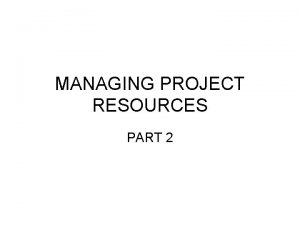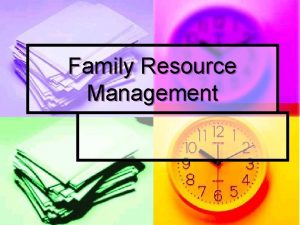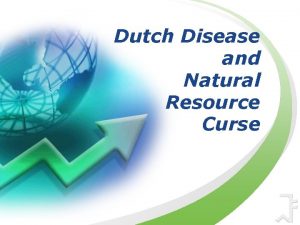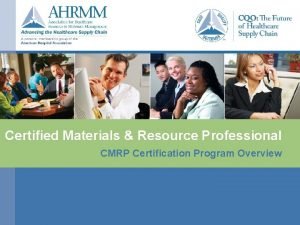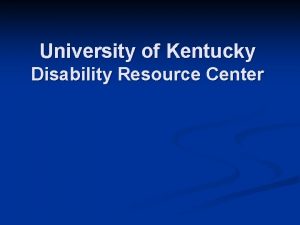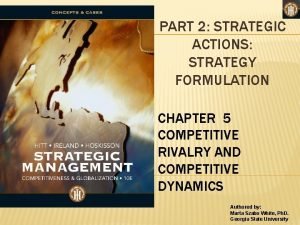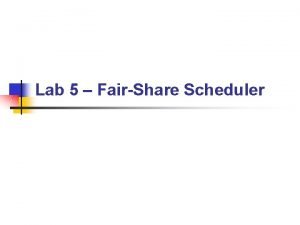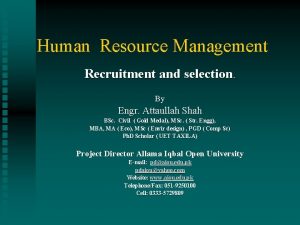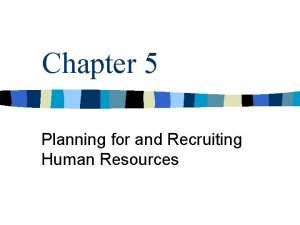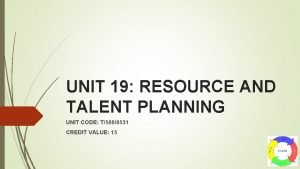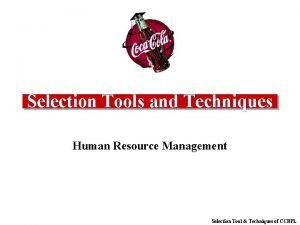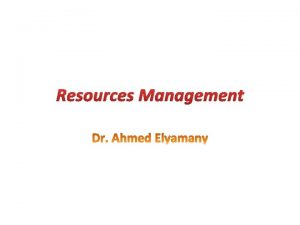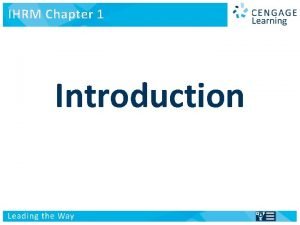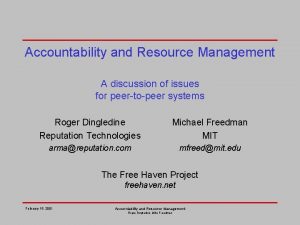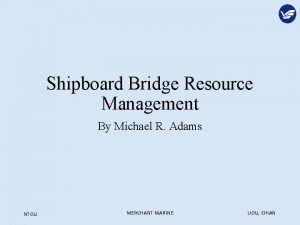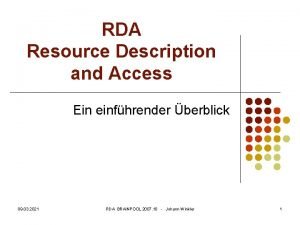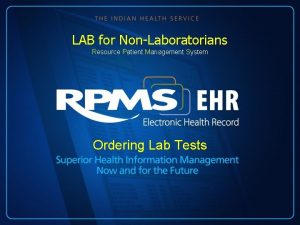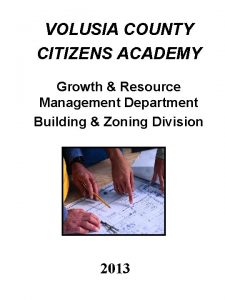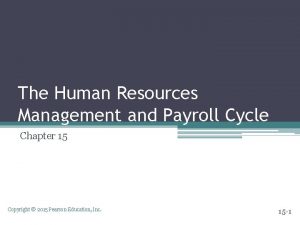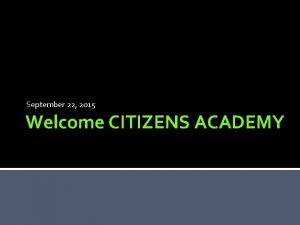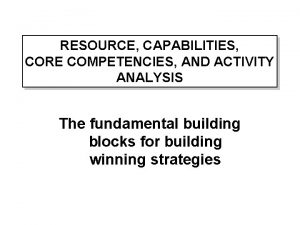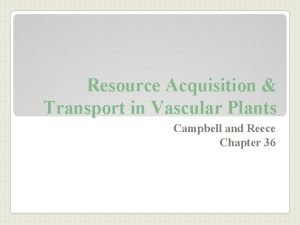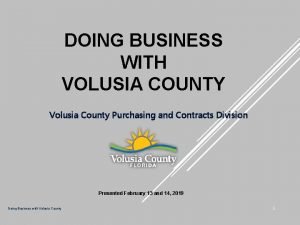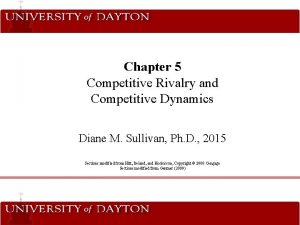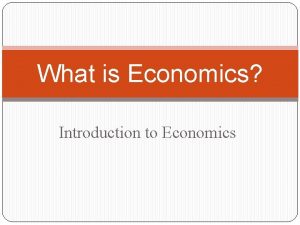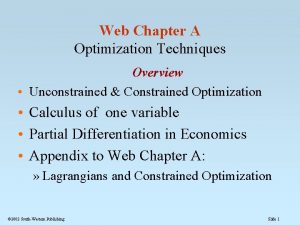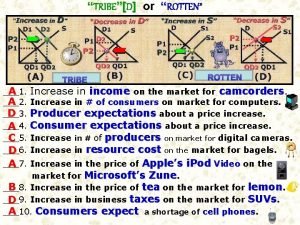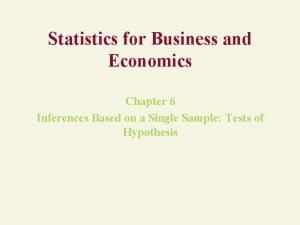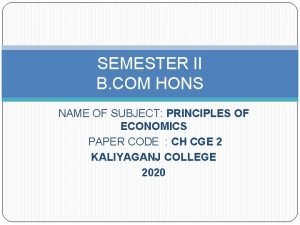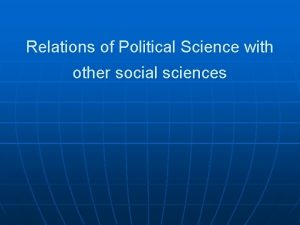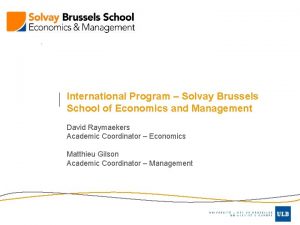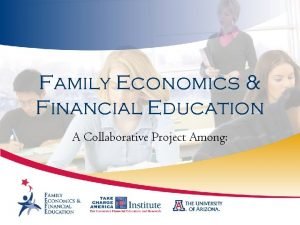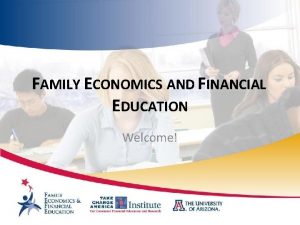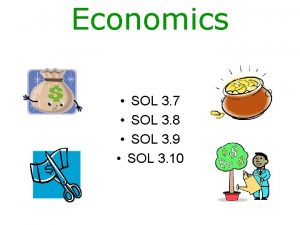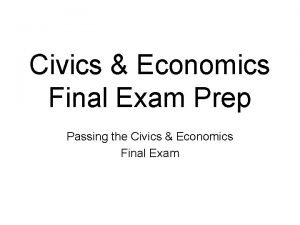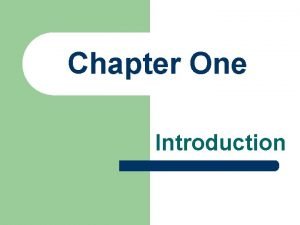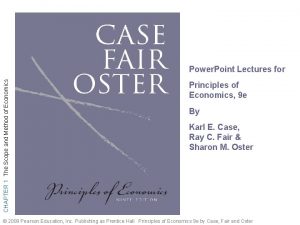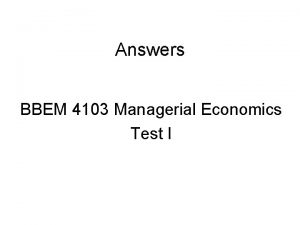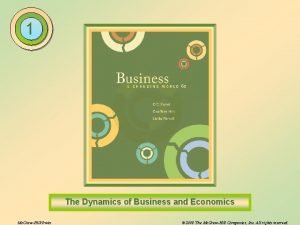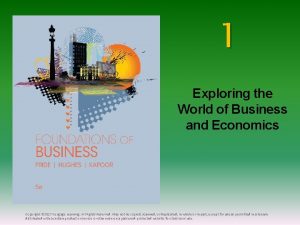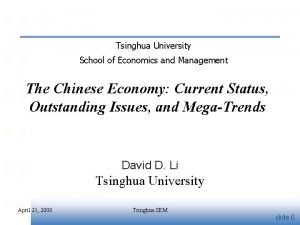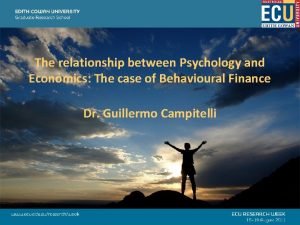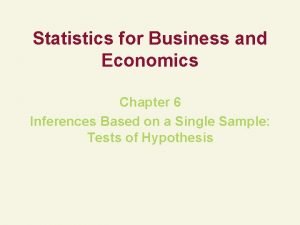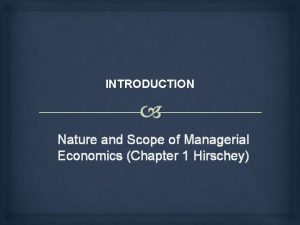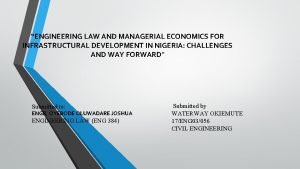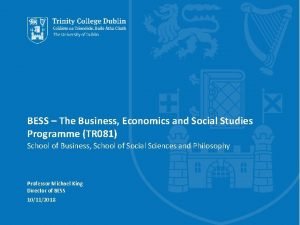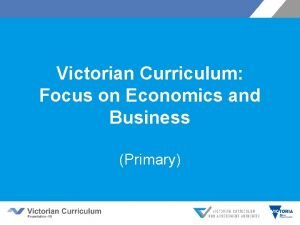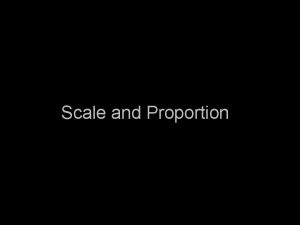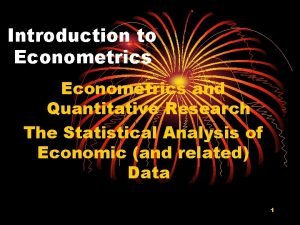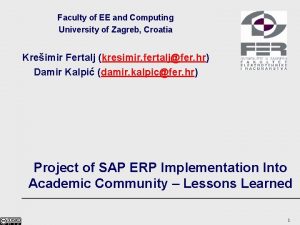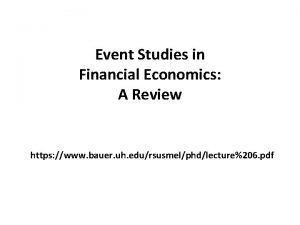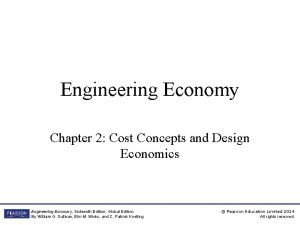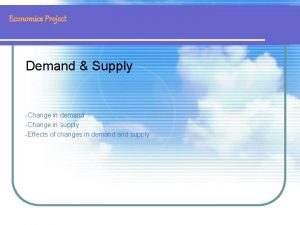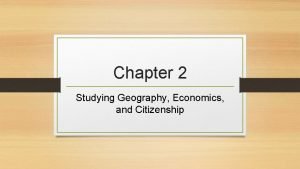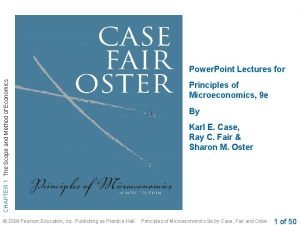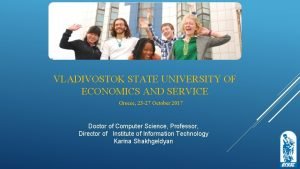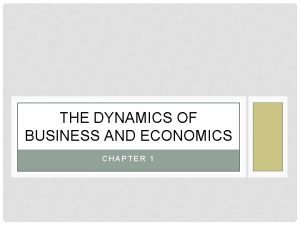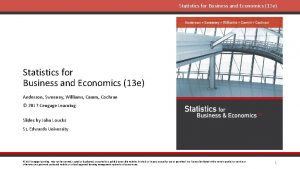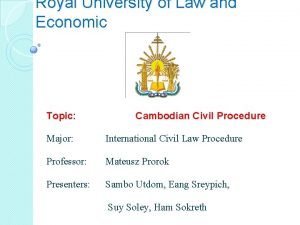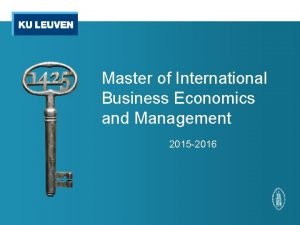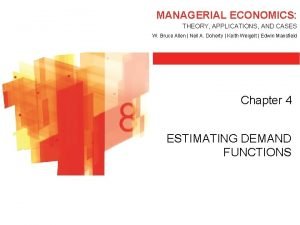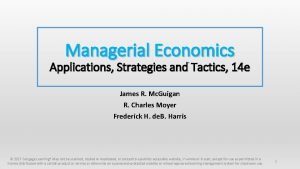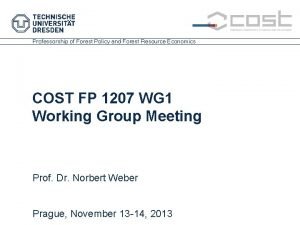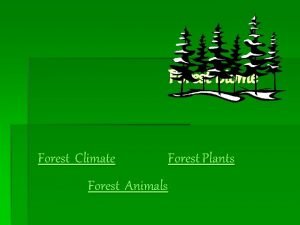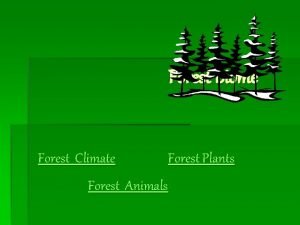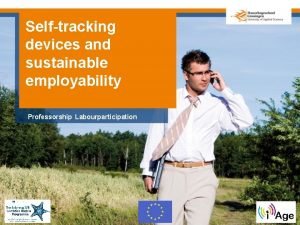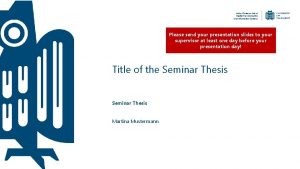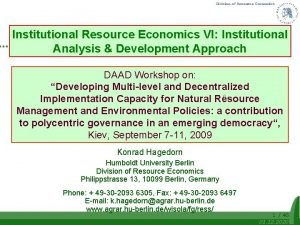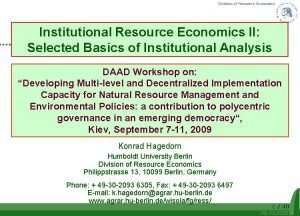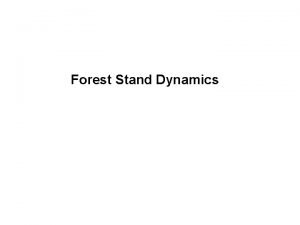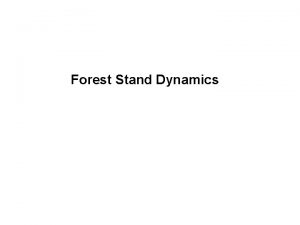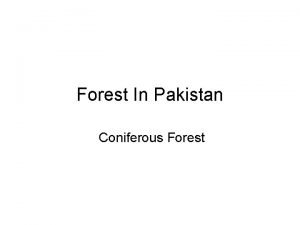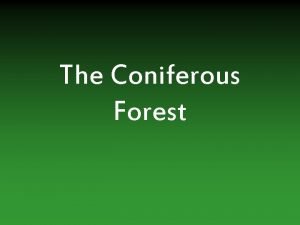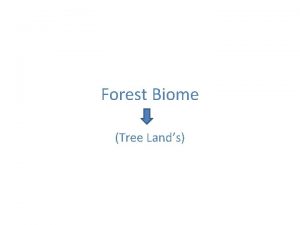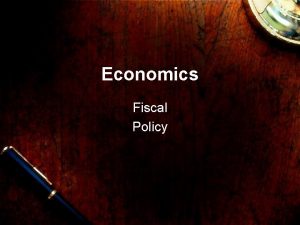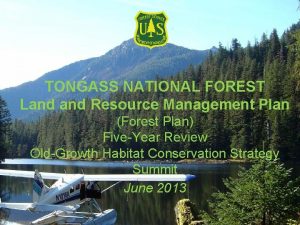Professorship of Forest Policy and Forest Resource Economics


















































































































- Slides: 114

Professorship of Forest Policy and Forest Resource Economics COST FP 1207 WG 1 Working Group Meeting Prof. Dr. Norbert Weber Prague, November 13 -14, 2013

Introduction • • Welcome Minute taker List of attendees Adoption of the agenda

Agenda 1. Discussion of presentations and posters (special purpose of the meeting) 2. Publication strategy – Country reports (synthesis reports) – State-of-the-art report – Special Issue in JFPE 3. Forest terminology and semantic wiki 4. AOB

9/17/2021 4

9/17/2021 5

Country-related synthesis reports • • General information Forest-related policy research Forest legislation and policy (actors, issues) Forest-related policy transposition (NFP, Natura 2000, EU Forest Strategy, EU Timber regulation…) • Further aspects (e. g. distinction between forest-focused and forest-related issues) 9/17/2021 6

Setting of WG 1 • Forest-related policy targets and measures: – qualitative research on the implementation of forest-related policy targets and measures (state-of-art by the international expert team and country reports by national teams); – recommendations to deal with vertical and horizontal subsidiarity; – interaction with WG 2 for the formulation of the requirements for policy modelling and analysis tools.

What is our common interest in WG 1? Forest-related policy targets and measures: – qualitative research on the implementation of forest-related policy targets and measures (state-of-art by the international expert team and country reports by national teams); – recommendations to deal with vertical and horizontal subsidiarity; – interaction with WG 2 for the formulation of the requirements for policy modeling and analysis tools.

STSM Short Term Scientific Mission for COST Action FP 1207 • Authors: Dr. Luc Boerboom* (valentina. ferretti@polito. it), Johann Rathke***, MSc (Johann. Rathke@forst. tu-dresden. de) l. g. j. boerboom@utwente. nl) and Dr. Valentina Ferretti** ( • Title: Forest policy and policy science: mapping policy concepts and theoretical perspectives • Part 1: Development of concept domains. Applicant Dr. Luc Boerboom • Part 2: Elaboration of concept domains into concept maps. Applicant Dr. Valentina Ferretti 9/17/2021 9

Policy analysis might result in uncomfortable news…

Excerpt from the protocol of WG 1 meeting on 18 June 2013 d) Special issue • Selected scientific papers according to the COST Action’s topic shall be collected in a special issue of the Journal of Forest Policy and Economics. Therefore, a WG meeting is planned for November 2013. 9/17/2021 11




9/17/2021 15

AOB • • Looking for further contributions for the special issue? Country reports STSM ideas Time and venue of the next meeting 9/17/2021 16

9/17/2021 17

Tasks of WG 1 – to be elaborated more in detail Outcome-oriented issues • Identifying best practices and gaps in forest policy formulation and evaluation on national/subnational level • Assessing processes around forest policy in multi-level systems (pan-European - EU – national - subnational) Research-oriented issues • state of the art in forest policy analysis in the participating countries • Recommendations for modelling forest policy processes – Agent-based modelling? – …

Next steps • • Call for participation in the working group Selection of international experts Selection of national experts One-page info for national members (using text from the Mo. Us) Defining requirements for WGs Workshop “policy targets and measures” to be held in 2013 Special issue “state of the art and country reports” Identifying candidates and themes for the STSMs 9/17/2021 19

COST FP 1207 ORCHESTRA: WG 1 Forest-related policy targets and measures 9/17/2021 20

Working Group 1: Reporting System 9/17/2021 21

9/17/2021 22

Bypassing national forest policy Rathke 2013


Policy Research and Analysis Paradigms Major Objective Academic Social Science Research Construct theories for understanding society Policy Research Predict impacts of changes in variables that can be altered by public policy Policy Analysis Systematic comparison and evaluation of alternatives available to public actors for solving social problems Policy Evaluation “Client” “Truth, ” as defined by the disciplines, other scholars Actors in the policy arena; the related disciplines Specific person or institution as decision maker Common Style Rigorous methods for constructing and testing theories; usually retrospective Application of formal methodology to policyrelevant questions; prediction of consequences Time Constraints General Weakness Rarely external time constraints Often irrelevant to information needs of decision makers Sometimes deadline pressure, perhaps mitigated by issue recurrence Difficulty in translating findings into government action Synthesis of existing research and theory to predict consequences of alternative policies Strong deadline pressure— completion of analysis usually tied to specific decision Myopia resulting from client orientation and time pressure Weimer & Vining 2011, modified


Professorship of Forest Policy and Forest Resource Economics Thank you for your attention! • nweber@forst. tu-dresden. de

PROBLEM ANALYSIS SOLUTION ANALYSIS 1. Understanding the problem 4. Choosing evaluation criteria (a) Receiving the problem: assessing the symptoms. (b) Framing the problem: analyzing market and government failures. (c) Modeling the 2. problem: Choosing and explaining identifying policy relevant goals and variables. constraints. 5. Specifying policy alternatives 6. Evaluating: predicting impacts of alternatives and valuing them in terms of criteria (Weimer & Vining, 1992) COMMUNICATION Conveying useful Advice to clients 7. Recommending actions. 3. Choosing a solution method. INFORMATION GATHERING Identifying and organizing relevant data, theories and facts; using facts as evidence about future consequences of current and alternative policies. Figure 8. 1: A summary of Steps in the Rationalist Mode

Weimer & Vining 2011

Weimer & Vining 2011

Theories of the Policy-making Process • The first generation of policy-making process theories – Scientific-rational model – Incrementalist model – Garbage can model • The second generation of policy-making process theories – – – Comprehensive rational model The stages heuristic model New Institutionalism model The multiple stream model The discourse model

Perspectives and Processes in Policy Studies

Processes for sustainable development and the international forest regime http: //www. fao. org/forestry/13551 -02 fc 7911 f 88 b 28 bc 54 b 804 ba 382712 c 38. gif

International Forest Regime Complex UNFF F F WTO free trade-regime F Fragmented IFR-C F FOREST UN-CBD-regime F F F Other implicit and explicit rules, norms and principles relating to forests UN-FCCC-regime Giessen 2011

Excursion: Intensity of forest discourses Arts et al. 2010

Policy science is about recognizing patterns…


Forest Strategy 2050 for Saxony

Forest Strategy 2050 for Saxony Background – International Year of Forests 2011 – Forest Strategy 2020 of the Federal Government (adopted in 2011) Rationale – demonstration of solutions to reconcile the natural potential of Saxonian forests and the expected societal demands Waldstrategie 2050 Sachsen – Strategy of the Saxonian Government

Forest Strategy 2050 for Saxony (2) Developed on the basis of … – Actual results of science and research – Opinions of the Landesforstwirtschaftsrat – Opinions of further partners with economic and social interests affected by the strategy Waldstrategie 2050 Sachsen

Forest Strategy 2050: Fields of action • • • Forest area Forest ownership Forest structure Continuity of forest functions Potential of wood from forests Forest and nature conservation Forest and recreation Forest and employment Forest and innovation Forest and environmental education General orientation forests and forestry Waldstrategie 2050 Sachsen

„Your opinion towards the Forest Strategy 2050“ All citizens are welcome to Communicate their opinion to the State Ministry of Environment and Agriculture until April 30, 2013 participation on level two

Groups of actors influencing forest policies • • • Ministeries, Authorities, Administrations Forest Owners and Landowners‘ Associations of the Forest and Paper Industries Associations of Forest Professionals and Trade Unions Hunting Associations Environmental and Nature Conservation Organizations • • Regional planning Tourism and sports Water supply Further organizations

Participation in Nature Conservation opinions Expert Opinion (§ 57 (1) Sächs. Nat. Sch. G) Nomination for the members of the advisory board Authorities for Nature Conservation Chair/ manageme nt Briefing SMUL (oberste Nat. Sch. Behörde ) Landesdirektion Sn (obere Nat. Sch. Behörde) Landratsämter/ Kreisfreie Städte (untere Nat. Sch. Behörde) Composition (Members, Appointment) Chaired by the respective head of the nature conservation agency Advisory Boards for Nature Conservation Level of substate level conservation agencies. N Justification in case of nonconsideration Saxony (according to § 56 Sächs. Nat. Sch. G) Guid ance Accredited organisations of Nature Conservation Projects, plans, administrativ e procedures Representation Opitions / right to sue Working Group Conservation (LAG)

Veterinarians Animal Protection Nature Conservation Fisheries Hunter Profressionals Hunting Science Forestry Agriculture Hunting Cooperatives Hunting communities for certain animal species Hunters Ministry of Environment and Agriculture Advisory. State Board for Hunting Highest hunting authority advisory funkction Advisory Board for Hunting

Strategic alliance: Concerted opinion against the draft of the new hunting act - Saxonian forest owners‘ association - Landowners‘ association - Saxonian Forestry Association - Forestry Professionals - PEFC Saxony - Association of ecological hunting - Working group on close-to-nature forestry - Environmental NGO forests - Environmental NGO (Saxonian group of Fo. E) - local NGO

Quelle: Forst und Holz Nr. 20, 1998

Forest Policy Program of Saxony, 1998 • Elaborated by the Ministry of Agriculture, Food and Forests • Consisted of general principles and objectives of the Saxonian forest policy • Multifunctional forestry as sustainable, close-to-nature and environmental friendly land use • Preservation of forests as principal aim • Mulit-functional forestry includes sustainability, equal ranking and simultaneity of forest functions






Parlamentarische Exkursion 21. 09. 2011

• • • Im Staatsbetrieb Sachsenforst waren zum 1. 12. 2009 insgesamt 1541 Mitarbeiter fest oder befristet (davon acht auf Projekt- und acht auf Drittmittelstellen) sowie in Ausbildungsverhältnissen (167, davon 141 Auszubildende zum Forstwirt, zwei Auszubildende zum Gärtner in den Forstbaumschulen, zwei Auszubildende zum Zootierpfleger im Wildgehege Moritzburg sowie zehn Referendare und zwölf Forstinspektoranwärter) beschäftigt

• • Nach dem Beschäftigtenstatus handelte es sich dabei um 334 Beamte, 379 TV-L-Beschäftigte 1 sowie 661 TV-Forst-Beschäftigte 2. Bei rechnerischer Berücksichtigung der Teilzeitbeschäftigung, insbesondere wegen des bis 31. 12. 2010 geltenden Bezirkstarifvertrages im Bereich des TV-Forst, ergeben sich daraus 1261, 81 Vollzeitäquivalente.

Forest Policy in Germany • The Federal Republic of Germany is a federal state. Responsibility for the forests thus mainly lies with the Länder (the regional state). While the Federal Government merely sets the forest policy framework, the Länder are responsible for the formulation and implementation of concrete forest policy targets. Federal responsibility falls under the Ministry of Food, Agriculture and Consumer Protection (BMELV) its objective is to secure the positive development of forestry and the timber industry in order to benefit the climate, quality of life, innovation and jobs. Lawrence & Dudley 2012

• • SBS: 1515 Mitarbeiterinnen und Mitarbeiter in zwölf Schutzgebieten und drei Schutzgebietsverwaltungen 108 Staatswald und 63 Privat- und Körperschaftswaldreviere SBS, Geschäftsbericht 2010

Einbettung und Abgrenzung der Ressourcenpolitik Holz BAFU Schweiz 2008

EDM 6209 Policy Study in Education 7 Policy Process Study: Policy-Making Study

Perspectives and Processes in Policy Studies

Theories of the Policy-making Process • The first generation of policy-making process theories – Scientific-rational model – Incrementalist model – Garbage can model • The second generation of policy-making process theories – – – Comprehensive rational model The stages heuristic model New Institutionalism model The multiple stream model The discourse model

Policy-making Theory I: Comprehensive Rationalist Perspective • Comprehensive rational framework: The ideal-typical framework – Problem analysis • Pathology control approach • Desirability striving approach – Comprehensive information gathering – Solution analysis • Best solution approach • Satisfice approach

Policy-making Theory I: Comprehensive Rationalist Perspective • Harold Lasswells’ intelligence system for policy making – Intelligence: The stage of intelligence collection, which consists of • • Information of the status quo of the phenomenon to be intervene Information of causal relations among vital constituents in operation within the policy phenomenon Information of the feasibility of candidate solutions Cost-benefit analysis of candidate solutions

Policy-making Theory I: Comprehensive Rationalist Perspective • Harold Lasswells’ intelligence system for policy making – – – Promotion: The stage of considering the pros and cons of candidate solutions Prescription: The stage of making decision on the prescription of the course of action to be taken Invocation: The stage of laying down the rules and regulations based upon which the policy prescriptions can be invoked Application: The stage of carrying out the course of action stipulated in the policy by the designated authority. Termination: The stage of bringing the course of action to a close as designed Appraisal: The stage of evaluating the effectiveness or/even efficiency of the policy measures.

PROBLEM ANALYSIS SOLUTION ANALYSIS 1. Understanding the problem 4. Choosing evaluation criteria (a) Receiving the problem: assessing the symptoms. (b) Framing the problem: analyzing market and government failures. (c) Modeling the 2. problem: Choosing and explaining identifying policy relevant goals and variables. constraints. 5. Specifying policy alternatives 6. Evaluating: predicting impacts of alternatives and valuing them in terms of criteria (Weimer & Vining, 1992) COMMUNICATION Conveying useful Advice to clients 7. Recommending actions. 3. Choosing a solution method. INFORMATION GATHERING Identifying and organizing relevant data, theories and facts; using facts as evidence about future consequences of current and alternative policies. Figure 8. 1: A summary of Steps in the Rationalist Mode

Policy-making Theory II: Political Perspective • Criticism on comprehensive rational framework by incrementalism and the introduction of political rationality into the policy process study • Conceptual difference between political rationality and means-end rationality – – Means-end rationality refers to agency that a person acts in a conscious and knowledgeable “way in which the attainment of his goal can be maximized in the real world. ” (Dahl & Lindblom, 1992, p. 57) Political rationality refers to the agency that the person will make conscious and knowledgeable consideration of the political reality and its entailed constraints and opportunities, within which the maximization of the meansto-an-end / satisfice project is carried out.

• Policy-making Theory II: Political The new institutionalism framework of decision-making study Perspective – New institutionalism can be characterized as approaches in social science “developed in reaction to the behavioural perspectives that were influential during the 1960 s and 1970 s and all seeks to elucidate the role that institutions play in the determination of social and political outcome. ” (Hall & Taylor, 1996, p. 936) – As these approaches apply to public policy study, it emerges as a reaction to the means-end rational calculation model and argues that policy making process is not a pre-dominant rational calculating process. They asserted that policy making processes should be conceived predominantly as institutional processes; hence they are by definition influenced if not determined by the features, structures and cultures of the institutions, in which the policy making processes are supposed to undergo.

• Policy-making Theory II: Political The new institutionalism framework of decision. Perspective making study – Decision-making as rule following: The logic of appropriateness • James March’s thesis of dual bases of decision making – Decision-making as rational calculation of preferences and self-interests governed by the Logic Consequence – Decision-making as rule following governed by the Logic of Appropriateness

• Policy-making Theory II: Political The new institutionalism framework of decision. Perspective making study – The logic of appropriateness… • Logic of appropriateness: “When individuals and organizations fulfill identities, they follow rules or procedures that they see as appropriate to the situation in which they find themselves. Neither preference as they are normally conceived nor expectations of future consequences enter directly into the calculus. ” (March, 1994, p. 57)

• Policy-making Theory II: Political The new institutionalism framework of decision. Perspective making study – The logic of appropriateness… • Three basic questions in decision-making under the logic of appropriateness: (p. 58) – The question of recognition: What kind of situation is this? – The question of identity: What kind of person am I? Or what kind of organization is this? – The question of rules: What does a person such as I, or an organization such as this, do in a situation as this?

• Policy-making Theory II: Political The new institutionalism framework of decision-making Perspective study – Pluralism: The simple institutional model • The general political system model: Pluralism as a theory of policy making or politics in general is generated from the political system model. In political system model, political process is characterized as input-process-output-feedback model. • Pluralistic model characterizes the policy making with the following attributes – Plurality of interest groups each with equal capacities in inputting political demands into the polity – The polity processes the plurality of political demands in impartial and indiscriminant manner – Plurality of administrative output to meet with plurality of political demands

• Policy-making Theory II: Political The new institutionalism framework of decision-making Perspective study – The action arena model (Ostrom, Gardner, and Walker, 1994): The action arena model reformulates the pluralist model by asserting that political actors in policy making process are not totally free and autonomous individuals but are confined in action arenas • Actors in action arena are endowed with different resources and information. They also bring with different valuation into the arena. As a result, different actors may and mostly will select different course of actions.

• Policy-making Theory II: Political The new institutionalism framework of decision-making Perspective study – The action arena model • Within an action arena a particular action situation will be constituted. The constituents of an action situation may includes – – The set of participants The specific positions to be filled by participants The set of allowable actions and their linkage to outcome The potential outcomes that are linked to individual sequence of actions – The level of control each participant has over choice – The costs and benefits, which serve as incentives and deterrents, assigned to actions and outcomes

Physical/Material Conditions Action Arena Attributes of Community Action Situations Patterns of Interactions Actors Evaluative Criteria Rules-in-Use Outcomes Figure 3. 1 A Framework for Institutional Analysis SOURCE: Adapted from Ostrom, Gardner, and Walker (1994, p. 37). (Sabatier, 1999, Figure 3. 1)

• Policy-making Theory II: Political The new institutionalism framework of decision-making Perspective study – – The policy network model This model characterizes that policy actors in policy making process are not act separately and independently. They will form networks and communities on the base of common policy focus, shared policy stance, related vested policy interest. Advocacy coalition model This model further specifies that the networking among policy actors in policy making process by put forth the concept of advocacy coalition. It indicates that policy actors will form coalition in order to advocate a particular policy choice. These coalitions will subsequently constitute a stabilizing parameter or institutional inertia within a policy area.

RELATIVELY STABLE PERAMETERS 1. Basic attributes of the problem area (good) Degree of consensus needed for major policy change 2. Basic distribution of natural resources 3. Fundamental sociocultural values and social structure 4. Basic Constitutional structure (rules) EXTERNAL (SYSTEM) EVENTS 1. Changes in socioeconomic conditions 2. Changes in public opinion 3. Changes in systemic governing coalition 4. Policy decisions Constraints And Resources Of Subsystem Actors POLICY SUBSYSTEM Coalition A Policy Coalition B a. Policy beliefs Brokersa. Policy beliefs b. Resources Strategy A 1 re B 1 re guidance instrument s Decisions sby Governmental Authorities Institutional Rules, Resource Allocations, and Appointments Policy Outputs Policy Impacts (Sabatier, 1999, Figure 6. 4)

• Policy-making Theory II: Political The state theory Perspective State theorists criticize pluralism and political system of treating the state as a blackbox or an impartial arbitrator of political demands. In replacement, they put forth different thesis on the natures and features of the modern state – – – The instrumental-state perspective The corporatist-state perspective The derivative-state perspective (To be explicated in details in Topic 10)

• Policy-Making Theory III: Multiple The approach grows out of the Garbage Can Model, which is Stream Approach another alternate policy-process model to the scientific- rational model in the 1970 s. The primary assumption of the model is the emphasis on the ambiguity nature of the policy phenomena. • By ambiguity, it refers to “a state of having many way of thinking about the same circumstances or phenomena. ” (Feldman, 1989, quoted in Zahariadis, 1999, p. 74) The concept of ambiguity differs from the concept of uncertainty, which is one of the constituent concept in rational model, is that uncertainty can be reduced or even eliminated by information and analysis of it, while ambiguity on policy phenomena cannot be reduced by information but in some case may even enhance it.

Policy-Making Theory III: Multiple Stream Approach • Another essential assumption of the approach is that policy issues or even problems are not attended in an analyticrational way as the scientific-rational model assumes. The garbage-can and multiple-stream models stress that the logic of approaching policy issue is temporal sorting and not rational choice. “Who pays attention to what and when is critical. Time is a unique, scarce resource. Because the primary concern of decision-makers …is to manage time effectively rather than manage tasks. It is reasonable to pursue a lens (approach) that accords significance to time rather than to rationality. ” (Zahariadis, 1999, p. 74)

Policy-Making Theory III: Multiple Stream Approach • John Kingdon’s three streams in policy making – Problem: It refers to the conditions or mechanism on which policy makers identify, define and take action on a policy problem. They include • • • Indicators Dramatic events or crisis Feedback of existing programs – Policy: It refers to the conditions spawned from the policy issues or phenomena themselves. They include • • Policy ideas generated from policy communities The prospect of technical feasibility and value acceptability of the policy itself – Politics: It refers to the conditions grow out of the political environment. They include • • National mood Legislative and executive turnover

Policy-Making Theory III: Multiple Approach – Stream The conception of the coupling of the streams and the • John Kingdon’s three streams in policy making formation of “policy window”. Kingdon signifies that when the three streams are joined together at critical moments in time, they will constitute a “policy window”. As a “policy window” opens, it indicates that the policy issue will elevate into a policy agenda and sequent policy-making steps will materialized.

Policy-making Theory IV: Discourse In discursive perspective, policy making is construed as Perspective language game of persuasion and argumentation. Hence, policy-making studies are analyses of how different parties concerned frame, organize and possibly win the argumentation in a policy discourse. • Formal argument model in policy analysis – Constituents in formal argument model (William Dunn) • • • Claim Information Warrant Backing Qualifier Rebuttal

I therefore C Policy-relevant Information is the beginning of a policy argument Claim affirms that the policy conclusion is true since W Warrant justifies the movement from I to C C becomes I in a sequent argument The Logical Structure of Policy Argument

therefore I C Mother tongue Instruction (MTI) enhance learning effectiveness MTI for all in compulsory education since W Findings of International Studies in Educational Achievement (IEA) for Science C becomes I in a sequent argument The Logical Structure of Policy Argument

I therefore Q Qualifier indicates that the claim has a given plausibility Policy-relevant Information is the beginning of a policy argument since W C Claim affirms that the policy conclusion is true as qualified unles s R Rebuttal indicates Warrant justifies the movement that special conditions, exceptions, or from I to C qualifications to W, or I reduce the plausibility of C because C becomes I in a sequent argument B Backing justifies W The Logical Structure of Policy Argument

I therefore Q On what subjects? At what levels? MTI enhance learning effectiveness since W Findings of IEA for Science C MTI for all in compulsory education unles s R Not in English Not at more advanced levels C becomes I in a sequent argument because B Backing justifies W The Logical Structure of Policy Argument

I therefore Q C Most of independent MTI for all States adopt in compulsory MTI education MTI enhance learning effectiveness unles s since W R UNESCO 1953 Document Not in most of post-colonial states C becomes I in a sequent argument because B Backing justifies W The Logical Structure of Policy Argument

Policy Argumentation: Interpretive • Formal argument model in policy analysis Approach – Constituents in formal argument model (William Dunn) • • • Claim Information Warrant Backing Qualifier Rebuttal – Types of argumentative claims • Designative claims on facts • Evaluative claims on values • Advocative claims on actions

Policy Argumentation: Interpretive • Interpretive approach to policy argument Approach – Deep description of arguments of different interpretive communities – Constituents of the architecture of argumentation and the textuality of argumentative/persuasive texts • Genre • Frame • Rhetoric • Narrative

• The Conception of Genre in Critical Concept of genre Discourse Analysis – “A genre is a group of texts that share specific discursive features. ” (Gill & Whedbee, 1997, p. 163). – Genre means “distinctions within convention …between text types. ” (Fairclough, 1995, p. 13) More specifically, Fairclough defines “genre as socially ratified way of using language in connection with a particular type of social activities, ” (Fairclough, 1997, p. 14) e. g. interview, narrative, exposition, argumentation, persuasion. – Accordingly policy text and/or discourse can mainly be construed as argumentative and/or persuasive genre of text and/or discourse.

• The Conception of Genre in Critical Concept of genre Discourse Analysis – According to Richard Edwards and his associates persuasive text may take the following forms • Deliberative genre: It refers to policy discourse which is “associate with policy and its future orientated and speculative. ” (Edwards et al. , 2004, p. 19) For example, in documents relating to recent education reform, they commonly refer to the future of global-informational economy and network society and how education reform should prepare students to fit into new species of flexible and workers and/or networkers. • Forensic genre: It refers to policy discourse which “focuses on past events and attempt to provide an account that is taken to be true. ” (ibid) For example, the rhetoric of presenting data of declining standards in comparative educational research and statistics of falling competitiveness of national economy in global market can be construed as a kind of forensic genre.

• The Conception of Genre in Critical Concept of genre Discourse Analysis – According to Richard Edwards and his associates persuasive text may take the following forms • Epideictic genre: It refers to policy discourse which focuses on the contemporary. However, in epideictic genre one can usually find “the notion of ‘naming and shaming’, publicly denouncing organizations and individuals who fail to meet the quality standards and inspection criteria to which they are subject. ” (ibid) For example, blaming on teachers, naming negative value-added schools, and shaming failing schools.

• Conception of Frame in Policy Studies Law and Rein define frame “as a way of representing knowledge, and as the reliance on (and development of) interpretative schemas that bound and order a chaotic situation, facilitate interpretation and provide a guide for doing and acting. ” (Law and Rein, 2003, p. 173)

Conception of Frame in Policy Studies • The concept of frame finds its scholarly resonance in the well-documented concept of “definition of situation” in symbolic interactionism. As Law and Rein quote in length of Goffman’s exposition “I assume that when individuals attend to any current situation, they face the question: ‘What is going on here? ’ Whether asked explicitly, as in times of confusion and doubt, or tacitly, during occasions of usual certitude, the question is put and the answer to it is presumed by the way the individual then proceeds to get on with the affairs at hand. ” (Quoted in Law & Rein, p. 175)

Conception of Frame in Policy Studies • The functions of frames in policy argumentation are to (Law & Rein, p. 174) – “note a special type of story that focuses attention” – “provide stability and structure by narrating a problemcentred discourse as evolves over time, ” – “define the boundary between evidence and noise”, – “wed fact and value into belief about how to act”

Conception of Frame in Policy Studies • Types of policy frame – Rhetoric frame – Action frame • Policy action frame: It refers to “the frame an institutional actor uses to construct the problem of a specific policy situation. ” • Institutional action frame: It indicates the frame held by institutions. This signifies that as agents of thought and action, institutions possess characteristics point of view, prevailing system of beliefs, category scheme, images, routines and styles of argument and action, all of which inform their action frames. ” (Schon & Rein, 1994, p. 33)

Conception of Frame in Policy Studies • Framing HKSAR education reform – Lifelong learning for employability and competitiveness – Lifelong learning for social inclusion and political empowerment • Framing Quality Education – Quality for analytic-technical control – Quality for communal understanding of trust and care – Quality for potential emancipation • Framing MOI policy – – MOI policy as issue of learning effectiveness MOI policy as issue of nation-building MOI policy as issue of social capital formation MOI policy as issue of human right

Conception of Rhetoric in Policy Studies • Meanings of rhetoric: Rhetoric has a long history in Western literary as well as philosophical traditions. It can be traced back to Aristotle. – Aristotle defines rhetoric as “the ability to see, in any given case, the available means of persuasion. ” (Aristotle, 1991, quoted in Gill & Whedbee, 1997, p. 155) – Wharley defines it as “the findings of suitable arguments to prove a given point, and the skillful arrangement of them. ” (Whately, 1963, quoted in Gill & Whedbee, 1997, p. 155)

Conception of Rhetoric • Meanings of rhetoric: in Policy Studies – A dictionary definition of rhetoric is that it is “the art of using language so as to persuade or influence others. ” (Edwards et al. 2004, p. 3) Hence, Rhetorical analysis involves the study of the ways in which we attempt to persuade or influence in our discursive, textual and gestural practices. (Edwards et al. , 2004, p. 13) Hence, “part of the job of the rhetoric analyst is to determine how constructions of ‘the real’ are made persuasive” (Simon, 1990; quoted in Edwards et al. , 2004, p. 13) “Here the question is not so much about whether reality matches rhetoric or not, but which fabrications of the real are more persuasive and why. ” (Edwards, et al. , 2004, p. 13) – As for the case of educational discourse, rhetoric analysis aims to explore and reveal “hidden rhetoric aspect to educational discourse. ” (Edwards et al. , 2004, p. 9)

• Constituents of rhetoric performance: It has. Studies been Conception of Rhetoric in Policy identified by analysts of rhetoric that there are several essential constituents for a rhetoric performance, i. e. to make rhetoric persuasive. They are – Context: Rhetoric by definition is pragmatic in nature, i. e. it “responds to or interacts with societal issues or problems, and it produces some action upon or change in the world. ” (Gill & Whedbee, 1997, p. 161). Therefore, in order to be comprehended and/or critically analyzed the rhetoric in a policy text, it must be set against the context (temporal, sociocultural and/or pragmatic contexts), in which it is derived.

• Constituents of rhetoric performance: Conception of Rhetoric in Policy Studies – Exigence: It refers to the way the issue and/or problem to be addressed in the rhetoric of a policy text are defined and formulated. For example, in recent education reforms, the most commonly used exigencies are either the decline of standards of students and school leavers or the threat of losing national competitiveness in global economic competitions.

• Constituents of rhetoric performance: Conception of Rhetoric in Policy Studies – Audience: It signifies the actual or figurative audience, whom the rhetoric of a policy text suppose to address or appeal to. For example, in recent education-reform documents, the audiences to be addressed are usually employers and/or parents rather than teachers and education professions. It indicates a sense of distrustfulness to professionals, who usually been depicted as the sourced of falling standard in education and/or falling competitiveness in national economy. Even within the audience of parents, they has been defined as consumers striving for individual gains rather than as citizens constituting common will and good for the society as a whole.

Conception of Rhetoric in Policy • Constituents of rhetoric performance: Studies – Rhetor credibility: It indicates the authorities of the speakers or writers of the texts, and/or the authorities that the rhetoric of a policy documents try to appealed to. For example, appeal to concepts as well as authorities of neo-liberal economists, such as Milton Friedman, in policy texts of education reform of liberalization is one of the most common practices in recent education reforms. – Absence: It has been underlined that one of the essential components in analyzing rhetoric is “what is absent from or silenced by the text. ” (Gill & Whedbee, 1997, p. 169).

• Constituents of rhetoric performance: Conception of Rhetoric in Policy Studies – Metaphor: “The essence of metaphor is understanding and experiencing one kind of thing in terms of another. ” (Lakoff and Johnson, 1980; quoted in Edwards, 2004, p. 25) In metaphoric analysis, it is claimed that “human understanding is a metaphoric process; the mind grasps an unfamiliar idea only by comparison to or in terms of something already known. Thus the metaphoric language in a text presents a particular view of reality by structuring the understanding of one idea in terms of something previously understood. ” (Gill & Whedbee, 1997, p. 173) – For example, in the rhetoric of the neo-liberalism the education system is metaphorically prescribed as a market mechanism, a school as a input-output factory, students as materials to be processed and added on value, parents as choosing consumers, school principals as CEO, etc.

• Constituents of rhetoric performance: Conception of Rhetoric in Policy – Studies Iconicity: “Iconicity functions in a way that is similar to metaphor, iconicity ‘rests on the intuitive recognition of similarities one field of reference (the form of language) and another. ’” (Gill & Whedbee, 1997, p. 174) For example, HK school like to use celebrity graduates as rhetoric to indicate the quality of the school.

Conception of Narrative in Policy Studies • Conception of narrative in policy study – Narrative can be defined as literal representation which takes the form of a storyline, i. e. with clear beginning, development, and end. – It refers to the ‘storyline’ that each interpretive community constructs, follows and put fore in a policy argumentation. It is a representation schema a interpretive community used to define their situation in the policy reality and organize their arguments.

Conception of Narrative in Policy Studies • The structure of narrative: Numbers of scholars have tried to summarize the structure of a narrative. Here Hyden White’s formulation will be adopted – Central subject: The narrator or the main character in the story. In the case of policy argumentation, the central subject is a particular interpretive community/interest group. – Plot: • • • It refers to the sequence of events selectively organized into a narrative by an interpretive community in the policy argumentation. It represents “a structure of relationships by which the events contained in the account are endowed with a meaning by being identified as parts of an integrated whole” (P. 9) “The plot of a narrative imposes a meaning on the events that make up its story level by revealing at the end a structure that was immanent in the events all along. ” (p. 20)

Conception of Narrative in Policy Studies • The structure of narrative: – Closure: • • • It refers to the resolution, evaluation and even moral meaning elicited from the precedent sequence of events, i. e. plots. As White indicates “a proper historical narrative … achieves narrative fullness by explicitly invoking the idea of a social system to serve as a fixed reference point by which the flow of ephemeral events can be endowed with specifically moral meaning. … (Hence), the chronicle must approach the form of an allegory, moral or analogical as the case may be, in order to achieve both narrativity and historicality. ” (p. 22) As in the case of policy narrative, the closure performs the function of resolving the policy alternatives and/or conflicts, evaluating the policy choices, and attributing moral meanings to the policy conclusion. But most importantly these resolution, evaluation and attribution are all constructed according to the worldview and/or vested interest of the interpretive community concerned.

Conception of Narrative in Policy Studies • The structure of narrative: – Authority: Narratives will usually be present in authoritative manner as if they are the establishment of facts, order and even truth

Conception of Narrative in Policy Studies • Narrative identity and decision-making by rule following By relating James March’s institutionist thesis of decision-making by rule following with the interpretive approach to narrative identity of interpretive communities

Conception of Narrative in Policy Studies • Narrative identity and decision-making by rule following – – – The conception of interpretive community can be construed as a community with a particular narrative identity on a policy issue As a result members of an interpretive community will follow the logic of appropriateness in making decision on policy issue Hence, they are most unlikely to approach the policy decision at hand in self-interest calculation orientation but to base the decision on the narrative identity of the interpretive community to which they have identified.

Perspectives and Processes in Policy Studies

7 Policy Process Study: Policy-Making Study END
 Foundation in general science in ireland
Foundation in general science in ireland Maastricht university school of business and economics
Maastricht university school of business and economics Environmental science chapter 2
Environmental science chapter 2 Resource leveling is the approach to even out the peaks of
Resource leveling is the approach to even out the peaks of Perbedaan antara resource loading dan resource levelling
Perbedaan antara resource loading dan resource levelling What is hr policies
What is hr policies Mathematical vs non mathematical economics
Mathematical vs non mathematical economics Ib economics fiscal policy
Ib economics fiscal policy Classical economics vs keynesian
Classical economics vs keynesian Environmental and resource efficiency issues
Environmental and resource efficiency issues Resource and cost planning
Resource and cost planning Lev and schwartz model example
Lev and schwartz model example Short term human resources
Short term human resources Human resources management final exam
Human resources management final exam Strategic human resource
Strategic human resource Slow-cycle market companies examples
Slow-cycle market companies examples Retail organization
Retail organization Chapter 11 forestry and resource management
Chapter 11 forestry and resource management Battling over clayoquot big trees
Battling over clayoquot big trees Deped human resource development plan
Deped human resource development plan Superfluous strengths
Superfluous strengths Activity resource usage model and tactical decision making
Activity resource usage model and tactical decision making Activity resource usage model and tactical decision making
Activity resource usage model and tactical decision making Human resource and job design in operations management
Human resource and job design in operations management How to create a resource loading chart
How to create a resource loading chart Induction definition in hrm
Induction definition in hrm Factors affecting the management of family resources
Factors affecting the management of family resources Resource curse and dutch disease
Resource curse and dutch disease What is cmrp certification
What is cmrp certification Ricoh uky
Ricoh uky Payroll cycle activities
Payroll cycle activities Usda linc
Usda linc Market commonality and resource similarity
Market commonality and resource similarity Lab and resource scheduler
Lab and resource scheduler Selection in human resource management
Selection in human resource management Chapter 5 human resource planning and recruitment
Chapter 5 human resource planning and recruitment Dane county aging and disability resource center
Dane county aging and disability resource center Resource and talent planning
Resource and talent planning Selection tools in management
Selection tools in management Resource aggregation
Resource aggregation Resource allocation graph and wait for graph
Resource allocation graph and wait for graph Difference between domestic hrm and ihrm
Difference between domestic hrm and ihrm Accountability and resource management system
Accountability and resource management system Bridge resource management questions and answers
Bridge resource management questions and answers Resource description and access
Resource description and access Resource ordering and status system
Resource ordering and status system Volusia county building department
Volusia county building department Payroll cycle activities
Payroll cycle activities Volusia county growth and resource management
Volusia county growth and resource management Resources and competencies analysis
Resources and competencies analysis Resource acquisition and transport in vascular plants
Resource acquisition and transport in vascular plants Health resource centers and libraries near pittsburg
Health resource centers and libraries near pittsburg Volusia county purchasing
Volusia county purchasing Standard cycle market example
Standard cycle market example Difference between scarcity and shortage in economics
Difference between scarcity and shortage in economics Wants and needs economics
Wants and needs economics Constrained and unconstrained optimization in economics
Constrained and unconstrained optimization in economics Tribe and rotten economics
Tribe and rotten economics What is the ha
What is the ha Relation between ac and mc in economics
Relation between ac and mc in economics Economics and political science relationship
Economics and political science relationship Opportunities and challenges of informational
Opportunities and challenges of informational Demand estimation and demand forecasting
Demand estimation and demand forecasting Managerial economics chapter 1
Managerial economics chapter 1 Mon gehol
Mon gehol Family economics and financial education
Family economics and financial education Family economics and financial education worksheet answers
Family economics and financial education worksheet answers Faculty of business and economics mendel university in brno
Faculty of business and economics mendel university in brno Wants and needs economics
Wants and needs economics Supply and demand economics project
Supply and demand economics project Civics and economics final exam
Civics and economics final exam Managerial economics define
Managerial economics define Long run in perfect competition
Long run in perfect competition The scope and method of economics chapter 1
The scope and method of economics chapter 1 Managerial economics test questions and answers
Managerial economics test questions and answers Aims of teaching economics
Aims of teaching economics Chapter 1 the dynamics of business and economics
Chapter 1 the dynamics of business and economics Exploring the world of business and economics
Exploring the world of business and economics Tsinghua school of economics and management
Tsinghua school of economics and management Psychology and economics relationship
Psychology and economics relationship International business finance and economics
International business finance and economics When to use z test and t test
When to use z test and t test Urban economics and real estate markets
Urban economics and real estate markets Take home pay
Take home pay Philosophy, politics and economics michael munger
Philosophy, politics and economics michael munger Media economics and the global marketplace
Media economics and the global marketplace Definition managerial economics
Definition managerial economics Example of micro economics
Example of micro economics Scope of managerial economics
Scope of managerial economics Elearningunideb
Elearningunideb How managerial economics is useful to engineers
How managerial economics is useful to engineers Cost theory and estimation
Cost theory and estimation Neptun bme
Neptun bme Budapest university of technology and economics rector
Budapest university of technology and economics rector Budapest university of technology and economics rector
Budapest university of technology and economics rector Trinity bess points
Trinity bess points Victorian curriculum economics and business
Victorian curriculum economics and business Perspective and methodology of economics
Perspective and methodology of economics What is the difference between proportion and scale?
What is the difference between proportion and scale? Econometrics and quantitative economics
Econometrics and quantitative economics Faculty of economics and business zagreb
Faculty of economics and business zagreb Event studies in economics and finance
Event studies in economics and finance Engineering economy 16th edition chapter 2 solutions
Engineering economy 16th edition chapter 2 solutions Midpoint formula economics
Midpoint formula economics Supply and demand economics project
Supply and demand economics project Chapter 2 lesson 1 studying geography
Chapter 2 lesson 1 studying geography The scope and method of economics chapter 1
The scope and method of economics chapter 1 Vladivostok state university of economics and service
Vladivostok state university of economics and service Chapter 1 the dynamics of business and economics
Chapter 1 the dynamics of business and economics Statistics for business and economics 13e pdf
Statistics for business and economics 13e pdf Seattle university business school
Seattle university business school Royal university of law and economics
Royal university of law and economics Ku leuven international business economics and management
Ku leuven international business economics and management Managerial economics: theory, applications, and cases
Managerial economics: theory, applications, and cases Managerial economics applications strategy and tactics
Managerial economics applications strategy and tactics





